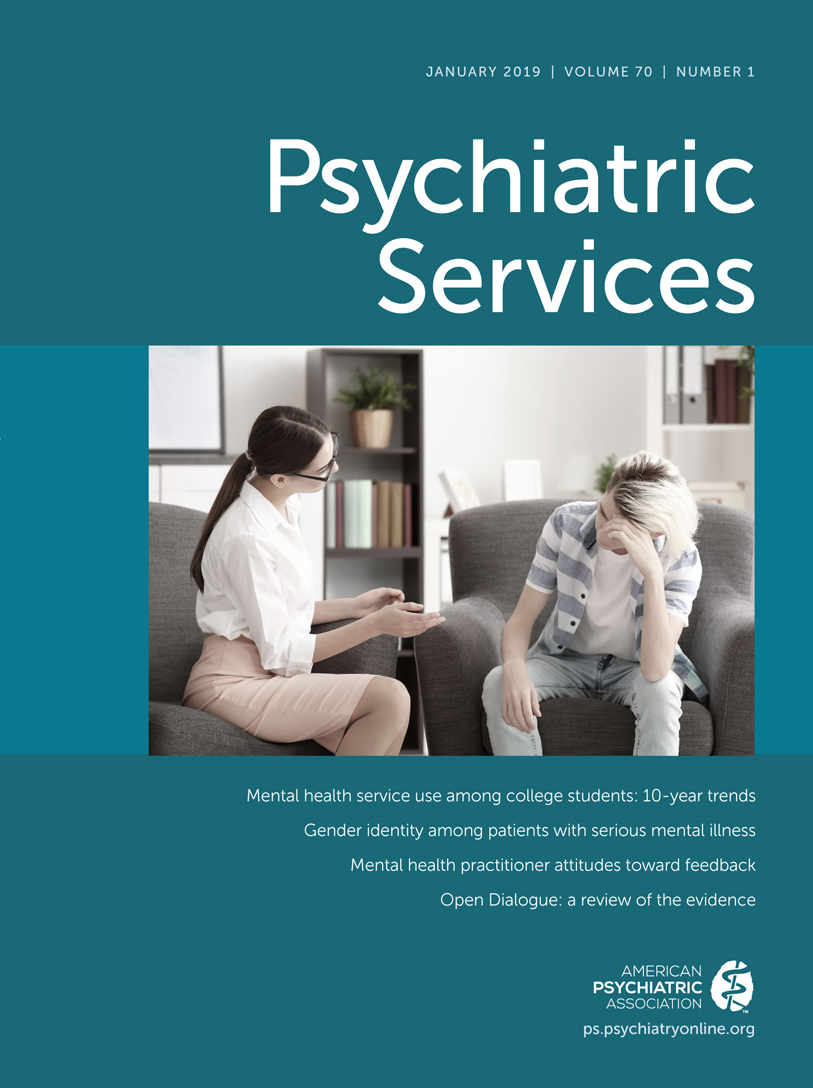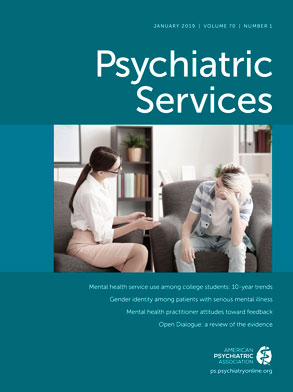The Intersection of Gender Identity and Serious Mental Illness
Transgender people, like all people, can suffer from serious mental illness, such as bipolar disorder, schizophrenia, posttraumatic stress disorder, and other psychiatric disorders that are enduring and heavily impair the ability to function in social relationships and at work or school (
1). Although people with serious mental illness respond well to comprehensive evidence-based treatment and can recover from their illness to enjoy satisfying lives, those who do not receive adequate care may become socially isolated and stigmatized (
1,
2). Likewise, transgender people face challenges in accessing standards-based medical care and can become marginalized from families and communities because of bias (
3). The high levels of discrimination and abuse experienced by transgender communities have been associated with increased prevalence of substance use disorders, posttraumatic stress disorder, and suicidality (
4–
6). For example, an estimated 40% of transgender adults have attempted suicide in their lifetime (
3). When antitransgender stigma and serious mental illness intersect, they create a particular vulnerability to morbidity and mortality (
4,
7).
The term “transgender” describes people who have a gender identity (i.e., one’s inner sense of gender) that differs from the one traditionally associated with their sex assigned at birth. Some transgender people have a nonbinary gender identity in that they do not identify as strictly a man or woman. Many but not all transgender people experience gender dysphoria, which refers to significant distress caused by a discrepancy between a person’s gender identity and sex assigned at birth. It is important to highlight that while gender dysphoria is listed in the
DSM-5 (
8), transgender identity is not and should not be considered a form of psychopathology. In addition, people can experience symptoms of gender dysphoria without meeting full
DSM-5 diagnostic criteria. When referring to gender dysphoria in this article, we include instances in which there is distress but not necessarily a diagnosis.
A small but growing body of research on the care of transgender patients indicates that gender dysphoria symptoms will improve or resolve among patients who receive evidence-informed gender-affirming medical care (
9). Gender-affirming treatments may include hormone therapy or surgeries that change a person’s physical characteristics to align with the person’s gender identity (
10). Of note, some transgender people cannot access these medical interventions; others choose to have some, but not all, available medical interventions. For example, some individuals receive hormone therapy but do not want any surgeries; some choose chest reconstruction but not genital surgery (
3).
With regard to treating gender dysphoria in patients with serious mental illness, there is a dearth of published literature (
11,
12), posing a challenge in offering evidence-based recommendations or tailored treatments. A systematic review of serious mental illness among lesbian, gay, bisexual, and transgender populations found only 27 articles between 1990 and 2015, and none included randomized controlled trials or pre-post intervention outcome evaluations (
11). Within this small set of articles, information pertaining specifically to transgender patients was limited to case reports on patients with psychotic symptoms and questions about whether a patient’s symptoms met diagnostic criteria for gender dysphoria or would be better explained by a psychotic disorder (
11). Based on recent case reports in the literature (
11,
12), standards developed by the World Professional Association for Transgender Health (
10), and our own clinical experience at a health center specializing in transgender health care (
13), we have developed recommendations for addressing gender dysphoria among patients with serious mental illness, with the understanding that more robust research must be conducted.
Gender Dysphoria Among Patients With Psychosis
Clinicians treating patients with serious mental illness may wonder whether a patient is experiencing gender dysphoria or is instead experiencing gender-related delusions that will disappear after a psychotic episode. Published reports indicate a tendency toward withholding gender-affirming medical treatments in the setting of psychosis, due to fear of misdiagnosis leading to irreversible interventions (
11). Recent case series, however, suggest that gender dysphoria is separate from psychosis and often predates the onset of psychotic symptoms (
11,
12). It is not uncommon for transgender people to first disclose their gender identity during an acute psychotic episode, but this can be due to a disinhibited state rather than to delusions. In these instances, people who have spent their lives hiding their gender identity may feel less concerned about antitransgender stigma, rejection, and abandonment during a psychotic episode and may therefore exhibit a less filtered expression of gender identity (
11,
12). Additionally, gender dysphoria and desire to transition are often disclosed in late adolescence or early adulthood, which overlaps with the period of vulnerability for first-break psychosis. Concurrent psychosis may delay a diagnosis of gender dysphoria (
11).
To help distinguish between delusions and true gender dysphoria, it is critical for clinicians to take a thorough history of gender identity development (
12). Clinicians will need to recognize the difference between the bizarre beliefs expected in delusions and the marked sense of incongruence between gender identity and sex assigned at birth that may persist long after optimized treatment of psychosis (
11). Because the literature suggests a trend toward improvement in psychotic symptoms with gender-affirming treatment (
11), we recommend that patients who meet diagnostic criteria for gender dysphoria and who possess medical decision-making capacity receive access to gender-affirming interventions. As with any medical intervention, patients should also demonstrate the capacity to both make an informed decision about gender-affirming treatment and safely engage in that treatment’s requirements. This clarification is important, as complete resolution of symptoms is not always feasible, and its pursuit by clinicians may perpetuate gatekeeping of medically necessary gender-affirming care (
10).
Systems of Care
Effective care models for transgender patients typically offer integrated systems that include primary care, behavioral health care, and collaborative working relationships with endocrinology and surgical services (
13). When transgender patients receive care in integrated gender-affirming environments, outcomes are more favorable than when fragmented care is received in clinical silos (
14). In the literature on serious mental illness in the general population, there is evidence for the effectiveness of assertive community treatment teams and wraparound services for inpatient care (
15). These services include 24-hour coverage by multidisciplinary treatment teams, integration of treatment and rehabilitation, small caseloads and frequent client contact, and close attention to illness management and daily living problems (
15). Another evidence-based model for integrated treatment of mental illness is psychiatric collaborative care. This model involves integrated teams of primary care providers and behavioral health professionals, supported by regular psychiatric case consultation. Though originally designed to treat depression, collaborative care is being expanded for a broader range of diagnoses and is increasingly relevant for serious mental illness (
16).
Like many health care providers, providers in these and other integrated service models generally lack training in the unique needs of transgender clients. We therefore recommend training staff on how to engage in effective, sensitive communication and how to create gender-inclusive care environments for transgender people with serious mental illness. Programs focused on serious mental illness can also partner closely with local transgender care agencies to integrate expertise and develop innovative, collaborative models of care for transgender people with serious mental illness. Through better partnerships between existing agencies focused on serious mental illness and gender affirmation, this underserved population will gain increased access to quality health care that meets both needs.

